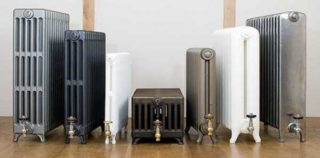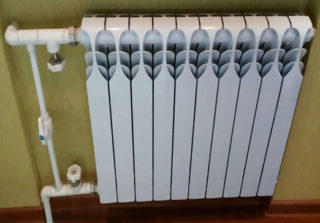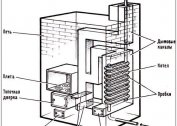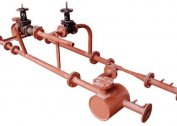To heat rooms in individual cottages, an autonomous heating system is used. At the design stage, they decide which heating radiators are best for a private house. It is important to create a favorable microclimate in living rooms and to maintain reasonable material savings. When choosing, it is necessary to take into account the operational characteristics of the equipment, its quality and cost.
Types of radiators for a private house
In homes, water heating is most often used. Radiators are installed along the outer walls in places of the greatest heat loss. Such a system has several advantages over the underfloor heating system: simpler installation, the possibility of smooth repair and replacement of individual parts.
Batteries for heating a house are shared:
- according to the material from which they are made: steel, cast iron, aluminum, copper, bimetal;
- by design - solid or from separate sections;
- by the principle of heat transfer: convection, radiating, combined.
Aluminum
Radiators made of aluminum are light weight, beautiful appearance, good heat dissipation, easy to install. They are used to heat cottages, when it is necessary to quickly heat the room and regulate the temperature of the coolant. This is a budget option. However, there are drawbacks: threaded joints wear out quickly, the coolant must not contain acidic compounds that destroy aluminum.
Steel
Steel batteries are optimal for heating a house. They are easy to assemble and install, they are light in weight, heat up quickly, you can adjust the temperature when installing the thermostat, and are reliable in operation. The disadvantages include the formation of corrosion and plaque on the inner rough surface.
Cast iron
Cast iron radiators - a classic option used in the heating system of buildings. Their main advantage is a long service life, in the houses of the old buildings preserved specimens that are more than 100 years old. Cast iron is resistant to corrosion, has high heat dissipation, retains heat for a long time, and heats up slowly.
Disadvantages - heavy weight, which makes it difficult to transport and install, the formation of scale inside the chambers, which reduces the passage and a decrease in the surface heating temperature.
Copper
Copper radiators are the most expensive heaters. They have a beautiful appearance, good heat dissipation, long life. The high price and strict requirements for installation and components make their choice not always justified. It is recommended to install if aggressive liquids are used as the heat carrier.
Bimetallic
The bimetallic battery consists of an inner layer made of an iron alloy, which ensures its strength, and an outer aluminum casing. Aluminum is characterized by high heat transfer, which allows you to quickly heat the room. It also gives the battery a stylish, neat appearance.
Bimetal radiators are designed for high working pressure, which is necessary to connect multi-story buildings to the central heating system. The installation of such batteries with autonomous heating of individual houses is impractical.
Varieties of radiators in design and principle of operation
Tubular batteries are a one-piece construction welded from pipes.The coolant passing through them heats the surface, which radiates heat and heats the room. Comfortable, durable, fit beautifully into the surroundings.
Sectional Radiators consist of several sections which are connected in a single whole. In them you can change the number of sections. It can be added if an insufficient number is chosen during the calculation, or removed after the building has been insulated. The disadvantage is the number of compounds, which increases the risk of leaks.
Panel radiators In addition to thermal heating panels, they have additional fins through which warm air is converted. They create a thermal curtain, which is convenient to use in rooms with large panoramic windows. Panel batteries have a stylish design, they are installed on the floor or hung on the walls.
Convector systems heating consist of metal tubes on which many horizontal fins are installed. They are installed in the casing, the front wall of which is missing. Through the gaps between the plates passes a stream of heated air. The natural movement of warm air allows you to heat the room faster than thermal radiation.
Such systems are used in rooms with high ceilings and wide windows. For heating, a smaller amount of coolant will be required than for other radiators. The only drawback of convector radiators is their high cost.
Vacuum radiators have chambers in which there is no air. The inner walls are coated with a mixture of lithium and boron. The boiling point of such a solution is +35 degrees, which reduces the energy consumption for heating the vacuum battery. They do not corrode, are easily mounted, fit into the interior.
Which batteries are better to choose

Heating in private homes differs significantly from heating in multi-storey apartments. In an autonomous heating system, the value of the coolant temperature and the pressure in the network are different. When choosing batteries for heating a house, the following factors are considered:
- The distance from the heating source to the radiator is small, the heat loss will be small, so the initial temperature is not required too high. According to this parameter, the capacity of the heating boiler is selected.
- To transfer heat over a short distance, less pressure is required in the system, the occurrence of water hammer is excluded. This allows the installation of thin-walled batteries.
- A small amount of liquid is required for heating.
- In a private house, heating is additionally protected from freezing temperatures. To prevent freezing, antifreeze or ethyl alcohol is added to the liquid. In the case of a long absence of tenants, the system is turned off, the liquid is drained from the pipes.
An important factor is the area that needs to be heated. This determines the performance of the heating unit. Here the rule applies - high-quality heating at a minimum cost.
Calculation of the number of sections

To select the number and type of heating radiators, a thermotechnical calculation is performed. Initially, it is accepted that for heating a room of 1 m2 with a height of 3 m, 1000 W of thermal energy will be required. To determine the amount of heat for specific conditions, correction factors are introduced.
With a room height of more than 3 m, the design power of radiators is increased by a multiple of exceeding the conditional. In a corner room with two windows, the average battery power is increased one and a half times. Important is the change in temperature of the coolant. When it is reduced by 10 degrees, the power of heating devices is increased by 15-20%.
The heat transfer depends on the connection diagram of radiators.Traditionally, hot coolant is supplied to the upper lateral inlet; reverse movement occurs along the lower outlet, located diagonally from the upper. The use of other schemes leads to heat loss of 5-10%.
Factors taken into account in the thermal calculation of the room:
-
- The number of exterior walls. The more of them, the higher the heat loss and the greater the required temperature. In the interior, heat loss will be negligible.
- The location of the walls around the world. Rooms located on the north or northeast side will require more heating. The southern and southwestern walls additionally receive heat from the sun, the rooms on these sides are well lit and heated.
- Take into account the location of the wind rose. Windward walls will cool faster.
- The minimum temperatures in the region. Choose the average indicators that happen in the coldest month of the year.
- The thermal conductivity level of the exterior walls. The basis is a wall made of hollow ceramic bricks with a thickness of two bricks. To obtain a comfortable temperature and reduce the cost of heating the room, the walls are insulated.
- Heat is lost through floors and floors. In a one-story house, additional warming of the underground is performed, a warm attic is arranged.
- Take into account the number and size of windows.
- An important parameter of thermal calculation is the number of entrance doors to the street or balcony. When they open, cold air enters the room and lowers the temperature.
This complex calculation is easy to do with an online calculator. Such a program can be found on the Internet and, by entering the required parameters, determine the amount of heat needed to heat the house.
Next, determine the number of heating sections of radiators. The amount of heat for heating is divided by the specific heat output of one section. Non-separable structures are considered as one section. There can not be more than 10 sections in one radiator, otherwise the coolant will not heat them to the desired temperature.
Specific power for various types are given in the table.
| Type of radiator | Maximum working pressure, bar | Section thermal power, W | The maximum temperature of the heat carrier, 0C |
| Cast iron | 6-9 | 80-160 | 120 |
| Steel | 10-12 | 150 | 110-120 |
| Aluminum | 6-25 | 190 | 130 |
| Bimetallic | 16-36 | 200 | 130 |
Most often, owners of individual houses opt for steel and aluminum heating radiators. Here the principle of "price and quality" is respected. Cast iron batteries are a thing of the past, and modern bimetal structures are quite expensive. Their use in autonomous heating systems is impractical.
What parameters to pay attention to
In autonomous heating, there are no pressure drops and water shocks, so choose batteries with thinner walls. You should pay attention to such points:
- the ability to heat up quickly and give off heat as much as possible;
- compliance with hygiene requirements and safety standards;
- the presence of a thermostat is welcomed; with it, a comfortable temperature is set;
- in overall dimensions should be optimally suited to the configuration of the room.
Radiators made of metal (steel or aluminum) are most suitable for individual houses. They heat up faster and give off heat, have a low price. Please note that the service life of metal batteries does not exceed 25 years.
Tips Before Buying
Before you go to buy heating radiators, it is necessary to perform a heat engineering calculation and determine the number of radiators for heating the house.
One of the cheapest options is aluminum radiators. With this choice, you should monitor the quality of the coolant. Liquids with an acidic and aggressive environment will quickly disable them.
Steel panel systems are also inexpensive with a high degree of heat transfer, quickly heat rooms, are organic in the interior of the house, and are resistant to damage.
If you don’t have to save money, you can stop at bimetallic radiators. They have good heat dissipation, beautiful appearance, they do not lose their attractiveness and high performance for 50 years.






